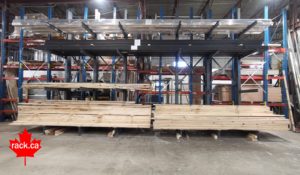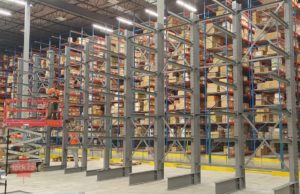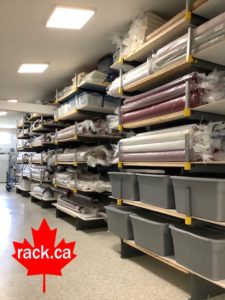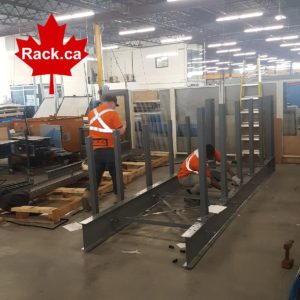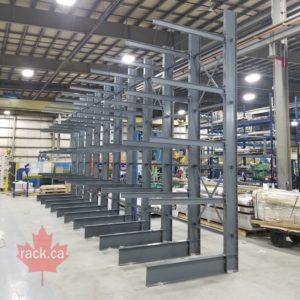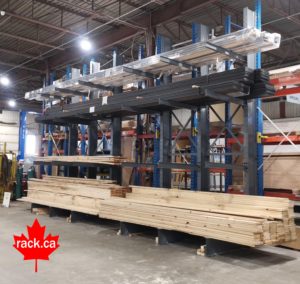Cantilever racks are an excellent storage solution for warehouses and distribution centers that stock large, heavy, or awkwardly shaped materials. From furniture to lumber, metal pipes, plywood, sheetrocks to steel bar stock and automobiles, cantilever racks can handle a multitude of heavy items.
Cantilever racking systems are a fairly common fixture in many warehouses, distribution centers, and manufacturing facilities because of their unparalleled durability and flexibility not to mention their high storage capacities. Additionally, cantilever racking systems are modular and can be configured in a number of different ways. They can be custom-designed to easily fit the layout and storage capacity of your facility. Ideal for both indoor and outdoor use, cantilever racking systems are also made to increase efficiency and safety standards in storage yards as well as warehouses.
Things to Consider before Buying Cantilever Racks
Before purchasing any new equipment—whether it’s storage racks or material handling machines—for your warehouse or storage facility, it’s important to take a few different factors into consideration.
First and foremost, measure out the layout of your facility and determine the storage capacity. This will give you a good idea of the types of materials you’re able to store as well as the type of racking system you need. Industrial cantilever racking systems in Toronto are fairly heavyweight and may require a great deal of space to maneuver around during the installation process.
Another important factor to take into consideration is the amount of downtime required to install new cantilever racking systems for your warehouse. Depending on the size and layout of the warehouse, you may need to account for a significant amount of downtime. Just make sure your budget adequately covers the cost of the product, installation, and downtime you may need.
Other important factors include the height of your facility and range of your material handling equipment. Make sure that the cantilever racking system you’re considering purchasing will clear the ceiling height and that your forklifts and other machinery can extend to reach the highest shelves. You’ll also have to spend some time and money training warehouse workers on how to safely use the new cantilever racking system.
What Are the Different Types of Cantilever Racking Systems?
There are two types of cantilever racking systems that are commonly used in warehouse facilities. The one that you choose for your facility depends largely on the types of items that you store. For the most part, however, both types of cantilever racks are durable and capable of handling large storage capacities.
Roll-Formed Cantilever Racks
Roll-formed cantilever racks are suitable for storing a wide range of products. They’re made of coiled sheet metal that’s rolled up to form a specific shape. Roll-formed cantilever racks are comprised of five components: braces, arms, bases, columns, and pins. The extensive arm-length capability offers excellent reach and easy access to stored items using a forklift or other material handling equipment.
Structural Cantilever Rack
Although they technically fall under the category of the same type of racking system, structural and roll-formed cantilever rack components aren’t interchangeable. Structural cantilever racks are engineered using structural steel I-beams that are designed to hold a significant amount of weight usually attributed to heavy weight products like car parts or entire automobiles.
Essentially, they’re designed exclusively for medium- to heavy-duty load capacities, which means roll-formed cantilever rack components are insufficient in this regard.
The arms on structural cantilever racking systems are attached to columns that utilize a secure four-bolt attachment that’s welded in place to strengthen the structural integrity.
When choosing between roll-formed and structural cantilever racking systems for your warehouse facility, it’s important to consider the design and weight of the different types of products that will be stored there. Plus, you need to train your employees on how to safely and efficiently maneuver around both of these types of cantilever racking systems. Arm reach, storage capacity, durability, and flexibility are of the utmost importance when determining which cantilever racking system is the most suitable for your industrial applications.
What Are Cantilever Uprights?
Cantilever rack uprights are the metal support beams that stand upright (hence the name) or vertically and support the arms and base of the entire racking system. These beams prevent the entire racking system from collapsing and support the weight of all of the items stored there.
Cantilever racking systems are available in single and double-sided designs. Single-sided configurations can only support material storage on one side, whereas double-sided configuration can support storage on both sides.
As a safety precaution, it’s important to never attempt to install arms on both sides of a single-sided cantilever racking system as this could cause the entire structure to topple over due to the excess weight.
What Are Cantilever Arms?
Cantilever arms are the pieces that are attached to the upright beams. They extend outward to establish a firm storage space for moderate to heavy items. The arms are adjustable and can be moved up or down on the upright beam to give the shelving more or less height as needed and maximize space. Some arms also feature a lip at the end to prevent certain circular or heavy items from falling off the edge or being accidentally knocked down.
What Are Cantilever Braces?
Braces are placed between the rack uprights to stabilize the entire structure and connect the uprights to one another and create even weight distribution throughout the entire system. They should never ever be used for storage.
Cantilever Rack Assembly and Safety Considerations
There are five basic steps involved in safely and securely assembling cantilever rack systems in your warehouse facility:
- Measure the size of the load that you need to store.
- Determine the required arm length based on the depth of the load that’s going to be stored on the racking system.
- Determine the lateral spacing and load deflection from the center of one upright to another. This will ensure proper weight distribution and prevent damages or structural weakness.
- Measure the height of the uprights and the height between the different levels, so you can determine the number of arms you need based on load capacity.
- Finally, determine the total weight capacity of your cantilever rack shelves.
Industrial cantilever racking system safety standards begin with installation. Make sure you have the proper space and accommodations for this type of racking system. Furthermore, you should adequately train your employees on how to utilize these storage units safely and efficiently.
Buy Canadian-Made Cantilever Racking from Canadian Rack Technologies Inc.
Canadian Rack Technologies Inc. offers a wide range of warehouse racking storage solutions in Ontario. We’re proudly partnered with a number of renowned Canadian racking system manufacturers that provide custom-engineered components and units that are guaranteed to meet your industrial cantilever racking needs. Contact us today to learn more.
